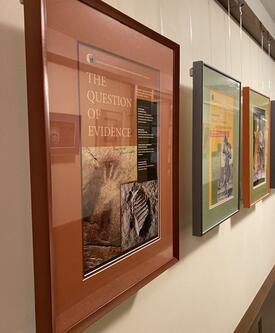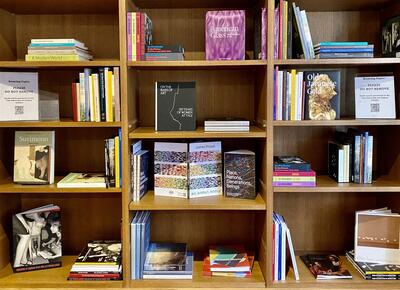I was amazed this January, returning to the Whitney Humanities Center after a semester on leave, by how much has been accomplished. I’m Rip Van Winkle, only my slumber was sabbatical, and now I’ve come back to an HQ I’d only imagined. And by the way, I owe this sabbatical slumber to my esteemed colleague Paul North, who rose to the challenge of interim directing in a most challenging time.
 The first thing I noticed were the framed event posters hanging along our corridors, worlds inside a world. “A history of the humanities in America since 1981,” Dean Tamar Gendler said about our Whitney walls. I’ve started to look again, putting together in my mind’s eye the story those posters tell. One of the intriguing aspects of this exercise involves guessing the year: some of the posters give no full date, as if events on campus lived in a perpetual present tense. Translation Matters, Food Matters, Hannah Arendt at One Hundred, Race and Caste, The Question of Evidence, Have the Humanities Betrayed Their Legacy?, A Henry Adams Colloquium, and a green and orange pair that gives me a bolt of energy: Patti Smith Master Class. Which event is the oldest? The most recent? When was Hannah Arendt’s hundredth? Or for extra points: Look only at the title, then guess the speakers. My favorite parlor game is to imagine how these events might look today—what different emphasis, which different fields and different speakers?
The first thing I noticed were the framed event posters hanging along our corridors, worlds inside a world. “A history of the humanities in America since 1981,” Dean Tamar Gendler said about our Whitney walls. I’ve started to look again, putting together in my mind’s eye the story those posters tell. One of the intriguing aspects of this exercise involves guessing the year: some of the posters give no full date, as if events on campus lived in a perpetual present tense. Translation Matters, Food Matters, Hannah Arendt at One Hundred, Race and Caste, The Question of Evidence, Have the Humanities Betrayed Their Legacy?, A Henry Adams Colloquium, and a green and orange pair that gives me a bolt of energy: Patti Smith Master Class. Which event is the oldest? The most recent? When was Hannah Arendt’s hundredth? Or for extra points: Look only at the title, then guess the speakers. My favorite parlor game is to imagine how these events might look today—what different emphasis, which different fields and different speakers?
A tremendous amount of behind-the-scenes work went on to put those posters in place. First, moving our favorites from 53 Wall. Moving duplicates, carefully, to the Whitney archive in Sterling Library. Then, once the posters were in place, hanging them. The hallways of HQ are plastered in Venetian plaster—putty made from fired limestone. Living with Venetian plaster walls, according to designer Leigh Herzig, quoted on a home decoration website, is like “living inside a Rothko painting.” You can’t drill holes for picture hangers inside a Rothko painting. That’s why the building managers came up with the ingenious idea of hanging the posters museum style, using transparent picture wire attached at the molding.
 As the building continues to fill up with people, we fill our bookshelves. Sara Carrigan reached out to Leonor Barroso at the Yale University Art Gallery, who sent us a shipment of books for our lecture room 136. Whitney speakers and fellows’ books now line the ornate book cabinets along one side of the room, and art books inhabit the shelves along the back wall. There are outward-facing display copies next to copies you can leaf through. Books by artists who have been associated with the Whitney are there, like James Prosek’s Art, Artifact, Artifice and William Bailey’s Looking through Time. A QR code is posted so that you can order any of these books from the YUAG bookshop; new titles will be added regularly.
As the building continues to fill up with people, we fill our bookshelves. Sara Carrigan reached out to Leonor Barroso at the Yale University Art Gallery, who sent us a shipment of books for our lecture room 136. Whitney speakers and fellows’ books now line the ornate book cabinets along one side of the room, and art books inhabit the shelves along the back wall. There are outward-facing display copies next to copies you can leaf through. Books by artists who have been associated with the Whitney are there, like James Prosek’s Art, Artifact, Artifice and William Bailey’s Looking through Time. A QR code is posted so that you can order any of these books from the YUAG bookshop; new titles will be added regularly.
If you have five or ten minutes to spare, please come to the Whitney corridor—to your left just as you walk through the main doors of 320 York—and imagine the humanities at Yale, past and present. I’d love to hear about what you see.
And if you’re far from HQ, please watch memorable Whitney talks here: https://whc.yale.edu/videos
All good wishes,
Alice
Alice Kaplan
Sterling Professor of French
Director, Whitney Humanities Center
February 28, 2022
